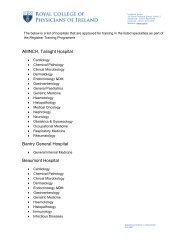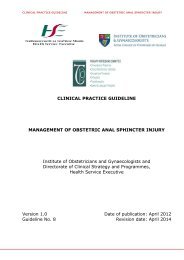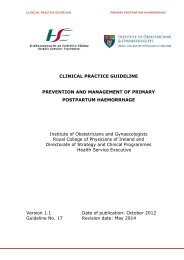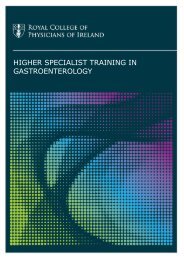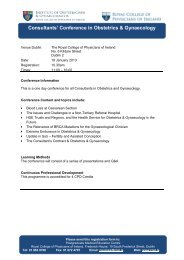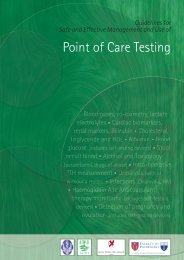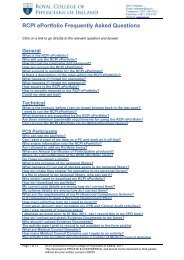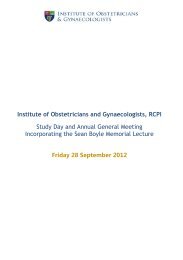Dr Terry O'Connor, Consultant in Respiratory Medicine, Mercy ...
Dr Terry O'Connor, Consultant in Respiratory Medicine, Mercy ...
Dr Terry O'Connor, Consultant in Respiratory Medicine, Mercy ...
Create successful ePaper yourself
Turn your PDF publications into a flip-book with our unique Google optimized e-Paper software.
<strong>Dr</strong> <strong>Terry</strong> O’Connor, <strong>Consultant</strong> <strong>in</strong> <strong>Respiratory</strong> Medic<strong>in</strong>e, <strong>Mercy</strong> University Hospital, Cork
Asthma - Treatment<br />
<strong>Dr</strong> <strong>Terry</strong> O’Connor,<br />
<strong>Consultant</strong> <strong>Respiratory</strong> Physician,<br />
<strong>Mercy</strong> University Hospital, Cork
Diagnosis of Asthma<br />
• Episodic symptoms of airflow obstruction are present.<br />
• Airflow obstruction is at least partially reversible<br />
– Spirometry is performed when the patient has avoided<br />
<strong>in</strong>haled β2-agonists for 12 hours and repeated 15-30<br />
m<strong>in</strong>utes after β2-agonist <strong>in</strong>halation. A rise of 12% or more<br />
and 200 mls <strong>in</strong> the FEV 1 constitutes significant reversibility<br />
• Alternative diagnoses are excluded
Goals for Asthma Control<br />
• Achieve and ma<strong>in</strong>ta<strong>in</strong> control of symptoms<br />
• Prevent asthma episodes or attacks<br />
• M<strong>in</strong>imal use of reliever medication<br />
• No emergency visits to doctors or hospitals<br />
• Ma<strong>in</strong>ta<strong>in</strong> normal activity levels, <strong>in</strong>clud<strong>in</strong>g exercise<br />
• Ma<strong>in</strong>ta<strong>in</strong> pulmonary function as close to normal as possible
Patients achiev<strong>in</strong>g control<br />
Only 8% of patients<br />
achieve asthma<br />
control<br />
Mann<strong>in</strong>g P, et al. AIRI Study Irish Medical Journal 2005
Risk Factors that Lead to Asthma<br />
Predispos<strong>in</strong>g Factors<br />
• Atopy<br />
• Genetic profile<br />
Causal Factors<br />
• Indoor Allergens<br />
– Domestic mites<br />
– Animal Allergens<br />
– Cockroach Allergens<br />
– Fungi<br />
• Outdoor Allergens<br />
– Pollens<br />
– Fungi<br />
• Occupational Sensitizers<br />
Contribut<strong>in</strong>g Factors<br />
• <strong>Respiratory</strong> <strong>in</strong>fections<br />
• Small size at birth<br />
• Diet<br />
• Air pollution<br />
– Outdoor pollutants<br />
– Indoor pollutants<br />
• Smok<strong>in</strong>g<br />
– Passive Smok<strong>in</strong>g<br />
– Active Smok<strong>in</strong>g
Asthma candidate genes<br />
Potential genes <strong>in</strong>volved <strong>in</strong> asthma pathogenesis<br />
• ADAM33 a dis<strong>in</strong>tegr<strong>in</strong> and metalloprote<strong>in</strong>ase-33 gene<br />
• PHF 11 possibly regulates lymphocyte activation, B cells<br />
& immunoglobul<strong>in</strong> synthesis<br />
• DPP10 may regulate chemok<strong>in</strong>es and cytok<strong>in</strong>es<br />
• GPRA a G prote<strong>in</strong>-coupled receptor<br />
Potential genes <strong>in</strong>volved <strong>in</strong> response to therapy<br />
• Polymorphisms <strong>in</strong> β 2-adrenoceptor gene<br />
• Polymorphisms <strong>in</strong> leukotriene C4 synthase gene<br />
Treatments of asthma <strong>in</strong> the future could conceivably be tailored<br />
to a patient’s specific genotype – DNA microarray chip
Allergy assessment and treatment
RAST versus Sk<strong>in</strong> tests<br />
IgE 324 kU/L (
RAST<br />
HDM<br />
6<br />
5<br />
4<br />
3<br />
2<br />
1<br />
0<br />
0 10 20 30 40 50 60 70<br />
Age (Years)<br />
r = -0.7057<br />
p < 0.0001<br />
Sheikh S, O’Connor TM. European Respir J 2006; 677s.
Asthma treatment
Classification of Asthma Medication<br />
Relief<br />
• Short-act<strong>in</strong>g β2-agonists – Salbutamol<br />
– Terbutal<strong>in</strong>e<br />
• Antichol<strong>in</strong>ergics<br />
– Ipratropium Bromide<br />
• Short-act<strong>in</strong>g theophyll<strong>in</strong>e<br />
– Am<strong>in</strong>ophyll<strong>in</strong>e<br />
• Adrenal<strong>in</strong>e <strong>in</strong>jections<br />
Control<br />
• Corticosteroids<br />
– Beclomethasone<br />
– Budesonide<br />
– Fluticasone<br />
• Sodium Cromoglycate<br />
• Long-act<strong>in</strong>g β 2 -agonists<br />
– Salmeterol, Formoterol<br />
• Long-act<strong>in</strong>g theophyll<strong>in</strong>e<br />
• Leukotriene receptor antagonists<br />
– Zafirlukast, Montelukast
GINA 2007
• Relievers<br />
• Inhaled<br />
bronchodilators<br />
– Ventol<strong>in</strong> ®<br />
– Bricanyl ®<br />
• Injectable agents<br />
– Xolair ®<br />
Types of Treatment<br />
• LTRAs<br />
– S<strong>in</strong>gulair ®<br />
• Theophyll<strong>in</strong>es<br />
– Uniphyll<strong>in</strong> ®<br />
• Controllers<br />
• Inhaled corticosteroids<br />
– Becotide ®<br />
– Beclazone ®<br />
– Pulmicort ®<br />
– Alvesco ®<br />
• Inhaled corticosteroids<br />
plus bronchodilators<br />
– Symbicort ®<br />
– Seretide ®
How MDI Technology Works
How DPI Technology Works
Controllers<br />
Inhaled Corticosteroids<br />
• Reduces airway swell<strong>in</strong>g over time, decreases airway hyperresponsiveness<br />
• Must be taken daily, even if no symptoms<br />
• Will not relieve acute asthma symptoms
Time courses of improvement with<br />
ICS therapy<br />
% improvement 100<br />
0<br />
No night<br />
symptoms<br />
Days<br />
FEV 1<br />
Weeks<br />
am PEF<br />
Months<br />
No SABA use<br />
AHR<br />
Years<br />
Woolcock AJ. Cl<strong>in</strong> Exp Allergy Rev 2001; 1:62
Side-Effects of Inhaled Steroids
Local<br />
Inhaled Steroids Side Effects<br />
• Hoarseness (5%)<br />
• Candidiasis - oropharyngeal and<br />
oesophageal (2%)<br />
• Local irritation - cough,<br />
bronchoconstriction (1%)<br />
Systemic<br />
• Hypothalamic - pituitary -<br />
adrenal axis<br />
• Osteopenia<br />
• Growth impairment<br />
• Sk<strong>in</strong> th<strong>in</strong>/bruis<strong>in</strong>g<br />
• Postcapsular cataract
Steroid Phobia: Unfounded!<br />
• Inhaled steroids <strong>in</strong> doses most often prescribed are very safe<br />
• Inhaled meds delivered directly to lungs where they are needed<br />
• Little systemic absorption if proper technique used
Xolair (Omalizumab)<br />
IgE Blocker Therapy<br />
• Dos<strong>in</strong>g based on IgE levels and weight<br />
• Only for ages over 12 years old<br />
• Must have evidence of specific allergy sensitivity<br />
• Used for those with poorly controlled asthma and noncompliant<br />
with standard recommended therapy<br />
• Delivered by Subcutaneous <strong>in</strong>jection
Asthma prevention<br />
• In all <strong>in</strong>fants breastfeed<strong>in</strong>g should be encouraged for at least 4-6<br />
months, and exposure to tobacco smoke should be avoided<br />
dur<strong>in</strong>g pregnancy and early childhood.<br />
• With high risk of allergy, the optimal age for the <strong>in</strong>troduction of<br />
selected supplemental foods should be 6 months, dairy products<br />
12 months, hen's egg 24 months, and peanut, tree nuts, fish,<br />
and seafood at least 36 months.<br />
• In homes of HR-<strong>in</strong>fants, evidence supports measures to reduce<br />
the levels of <strong>in</strong>door allergens.
Alternative Therapies<br />
• The reported level of use for adults ranges from 4% to 79%, and<br />
for children from 33% to 89%.<br />
• Four common treatments:<br />
– Breath<strong>in</strong>g techniques (<strong>in</strong>clud<strong>in</strong>g Buteyko)<br />
– Herbal products<br />
– Homeopathy<br />
– Acupuncture<br />
• There is no strong evidence for effectiveness for any of these<br />
modalities.<br />
• Futher research needed before any of these treatments can be<br />
recommended<br />
Holloway E, et al. Breath<strong>in</strong>g exercises for asthma. Cochrane Database Syst Rev. 2004;:CD001277. Review.<br />
McCarney RW, et al. Homeopathy for chronic asthma. Cochrane Database Syst Rev. 2004;:CD000353. Review.<br />
McCarney RW, et al. Acupuncture for chronic asthma. Cochrane Database Syst Rev. 2004;:CD000008. Review.
• Asthma is a chronic disease<br />
Conclusions<br />
• Control is the ideal, not lots of puffs of Ventol<strong>in</strong><br />
• The only way to achieve control is to take controllers regularly<br />
• Complementary therapies unproven<br />
• Total control is achievable for most patients
Denis Hickie<br />
Asthma without Limits<br />
Paul Scholes<br />
Ronan O’Gara<br />
Paula Radcliffe<br />
Mark Spitz



